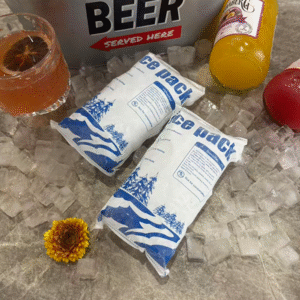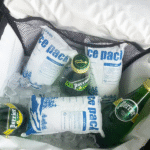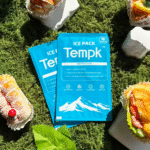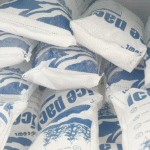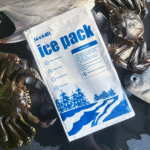Introdução
Na logística da cadeia de frio, pelotas de gelo seco e Pacotes de gelo seco tornaram-se ferramentas de refrigeração essenciais para manter a integridade do produto desde o armazém até o destino. Esteja você enviando vacinas, frutos do mar, ou amostras de laboratório, escolhendo a forma certa de gelo seco determina não apenas a estabilidade da temperatura, mas também sua eficiência operacional e controle de custos.
Nesta 2025 guia, você aprenderá como selecionar e aplicar soluções de gelo seco que atendam às suas metas logísticas, requisitos regulamentares, e padrões de sustentabilidade.
-
O principais diferenças entre pellets de gelo seco e bolsas de gelo seco
-
Melhores casos de uso em toda a indústria farmacêutica, comida, e setores de logística
-
Armazenamento e segurança práticas para manuseio de gelo seco
-
2025 inovações melhorando a sustentabilidade da cadeia de frio
-
Como fazer maximizar o desempenho de resfriamento enquanto reduz o desperdício
O que são pellets de gelo seco e como são usados na logística da cadeia de frio?
Pelotas de gelo seco são pequenas, pedaços cilíndricos de dióxido de carbono sólido (Co₂) projetado para rápido, resfriamento direto. Como eles sublimam – passando diretamente do estado sólido para o gasoso – eles não deixam nenhum resíduo líquido, tornando-os ideais para produtos sensíveis à temperatura.
Eles são amplamente utilizados em indústrias onde a manutenção de temperaturas ultrabaixas é crítica, incluindo envio farmacêutico, Amostras de biotecnologia, e transporte de alimentos congelados.
Como funcionam os pellets de gelo seco na prática?
Pellets de gelo seco absorvem rapidamente a energia térmica, produzindo resfriamento intenso a -78,5°C (-109°F). Esta rápida queda de temperatura garante que os produtos permaneçam congelados durante o transporte de longa distância. A pequena área de superfície dos pellets permite uma distribuição uniforme dentro de caixas isoladas ou contêineres de transporte, oferta cobertura térmica consistente.
Visão geral comparativa: Pelotas de gelo seco vs.. Outras opções de resfriamento
| Método de resfriamento | Faixa de temperatura | Duração | Aplicação ideal | Benefício do mundo real |
|---|---|---|---|---|
| Pelotas de gelo seco | -78.5°C | 24–48 horas | Envio ultrafrio | Nenhum resíduo líquido, Controle preciso da temperatura |
| Pacotes de gelo seco | -40°C a -60 °C | 36–72 horas | Resfriamento de médio prazo | Sublimação mais lenta, reutilizável, colocação flexível |
| Pacotes de gel | 0° C a -20 ° C. | 12–24 horas | Transporte de alimentos perecíveis | Amigável ao orçamento, reutilizável |
| Materiais de mudança de fase (PCM) | Personalizável | 24–96 horas | Biofarmacêutica ou kits de diagnóstico | Faixas de temperatura estáveis |
Dicas práticas para usar pellets de gelo seco
-
Para farmacêuticos: Use pellets de alta densidade em transportadores isolados a vácuo para máxima eficiência.
-
Para comida: Alinhe os pellets uniformemente sob e ao redor dos produtos para evitar o descongelamento parcial.
-
Para logística: Combine pellets com materiais de mudança de fase para transporte estendido em várias zonas.
Exemplo: Uma remessa de vacina que requer estabilidade de -70°C para 48 horas obtiveram resultados ideais usando 5 kg de pellets de gelo seco de 3 mm em um recipiente de EPS de alto desempenho, reduzindo o risco de deterioração por 40%.
Quando você deve usar bolsas de gelo seco em vez de pellets?
Pacotes de gelo seco são recipientes selados cheios de neve de CO₂ comprimido ou pasta de CO₂ congelada. Eles são projetados para fornecer maior duração de resfriamento com menos liberação de vapor, tornando-os ideais para remessas de temperatura média ou sistemas logísticos reutilizáveis.
Vantagens das bolsas de gelo seco em 2025 Operações da Cadeia de Frio
-
Duração estendida de resfriamento - Até 72 horas de temperatura estável.
-
Nenhum risco de contato direto – Mais seguro para trabalhadores que lidam com grandes remessas.
-
Design reutilizável – Reduz o desperdício de embalagens e os custos operacionais.
-
Tamanhos personalizáveis – Colocar caixas isoladas, Crates, e paletes facilmente.
Principais diferenças entre pellets e embalagens de gelo seco
| Recurso | Pelotas de gelo seco | Pacotes de gelo seco | O que isso significa para você |
|---|---|---|---|
| Velocidade de resfriamento | Muito rápido | Gradual | Escolha pellets para congelamento rápido; pacotes para resfriamento controlado |
| Reutilização | Uso único | Use múltipla | Os pacotes são melhores para remessas recorrentes |
| Manuseio | Requer EPI | Mais seguro de manusear | As embalagens reduzem a exposição ao CO₂ |
| Custo | Menor por kg | Maior por unidade | Depende da frequência de envio |
Visão do caso: Um exportador de frutos do mar substituiu o transporte baseado em pellets por bolsas de gelo seco reutilizáveis, reduzindo resíduos de embalagens por 60% mantendo a consistência de -40°C para 72 horas.
Como manusear e armazenar gelo seco com segurança em suas operações de cadeia de frio
O gelo seco oferece benefícios térmicos significativos, mas exige um manuseio adequado. Armazenamento ou ventilação inseguros podem causar aumento de pressão ou riscos de exposição ao CO₂.
Diretrizes de armazenamento
-
Armazene gelo seco em áreas ventiladas, nunca em recipientes herméticos.
-
Mantenha salas de armazenamento entre -80°C e -20 °C para retenção ideal.
-
Evite contato direto com a pele; sempre use luvas isoladas.
-
Gire o inventário usando o primeiro em, primeiro a sair (FIFO) sistema.
Dicas de transporte
-
Usar recipientes isolados com orifícios de ventilação para evitar o acúmulo de CO₂.
-
Rastreie temperaturas internas usando registradores de dados digitais ou sensores IoT.
-
Treinar a equipe em procedimentos de emergência para vazamentos de CO₂ ou casos de congelamento.
| Tipo de risco | Causa | Prevenção | Impacto em você |
|---|---|---|---|
| Co₂ acúmulo | Má ventilação | Instale exaustores | Evita riscos aos trabalhadores |
| Descongelamento do produto | Isolamento inadequado | Use EPS ou painéis de vácuo | Reduz a perda de produto |
| Frostbite | Contato direto | Use luvas isoladas | Garante a segurança do trabalhador |
Nota de segurança: Em 2025, a maioria das instalações logísticas está adotando sensores inteligentes de CO₂ integrados ao controle de ventilação por IA para manter a conformidade com a ISO 23412 padrões de segurança da cadeia de frio.
Como maximizar a eficiência do resfriamento e reduzir custos em 2025
O gelo seco continua a ser uma solução económica e sustentável quando aplicado estrategicamente. Para reduzir ambos desperdício de energia e custo de materiais, as empresas estão integrando monitoramento inteligente de temperatura e sistemas de resfriamento híbridos.
Estratégias de otimização
-
Use o formato certo: Pellets para congelamento instantâneo; pacotes para resfriamento constante.
-
Embalagem pré-resfriada: Reduz a taxa de sublimação em até 15%.
-
Combine com forros isolados: Prolonga a duração do resfriamento em 20–30%.
-
Monitorar perda de sublimação: Use dispositivos de rastreamento inteligentes para otimizar os ciclos de reabastecimento.
Dados da indústria (2025): As empresas que implementam sistemas híbridos de gelo seco relataram um 25% melhoria na consistência da temperatura e 18% redução nos custos de material de resfriamento.
Ângulo de Sustentabilidade
Os participantes modernos da cadeia de frio estão adotando Sistemas de recuperação de CO₂, permitindo a produção de gelo seco a partir das emissões capturadas – apoiando os objetivos da economia circular e a neutralidade de carbono.
2025 Tendências em tecnologia de resfriamento com gelo seco
O setor da cadeia de frio está evoluindo rapidamente, com a tecnologia de gelo seco na vanguarda da inovação em logística sustentável.
Principais avanços
-
Peletizadores Automatizados: Produza pellets de tamanho consistente, reduzindo o desperdício.
-
Folhas de gelo seco reutilizáveis: Combine flexibilidade de embalagens com poder de resfriamento de pellets.
-
Sensores de monitoramento inteligentes: Acompanhe os níveis de CO₂ e as taxas de sublimação em tempo real.
-
Integração de embalagens de base biológica: Reduzir plásticos descartáveis em caixas térmicas.
Insights de mercados emergentes
-
Cadeia de Frio Farmacêutica: Crescendo em 7.3% Cagr, impulsionado por remessas de medicamentos biológicos.
-
Entrega de comida para comércio eletrônico: Aumentou 35% em 2025, exigindo soluções de resfriamento de médio porte.
-
Logística Sustentável: Sobre 60% dos fornecedores agora adotam sistemas de embalagens reutilizáveis.
Perguntas frequentes
Q1: Quanto tempo duram os pellets de gelo seco em trânsito?
Tipicamente, 24–48 horas, dependendo da qualidade do isolamento e da temperatura externa.
Q2: As bolsas de gelo seco podem substituir as bolsas de gelo normais?
Sim, especialmente para remessas que exigem temperaturas abaixo de -40°C. Eles oferecem maior desempenho e nenhum resíduo de água.
Q3: O gelo seco é seguro para transporte aéreo?
Sim, mas deve cumprir Regulamentos de Mercadorias Perigosas da IATA (Seção 5.5.3), exigindo rotulagem e recipientes ventilados.
Q4: Como posso saber quanto gelo seco devo usar?
Como regra, alocar 5–10 kg de gelo seco por remessa de 24 horas por 100 litros de volume isolado.
Q5: Quais são as melhores alternativas ecológicas ao gelo seco tradicional?
Pellets de Bio-CO₂ e embalagens de mudança de fase reutilizáveis com invólucros externos recicláveis.
Resumo e recomendações
Pelotas de gelo seco e bolsas de gelo seco desempenham funções distintas na logística da cadeia de frio.
Pellets se destacam em rapidez, aplicações ultra-frias, enquanto os pacotes entregam de forma estável, resfriamento reutilizável por longos períodos. A escolha ideal depende da sensibilidade do seu produto, duração do transporte, e metas de sustentabilidade.
Takeaways -chave
-
Usar pelotas de gelo seco para operações farmacêuticas ou de congelamento rápido.
-
Escolher Pacotes de gelo seco para reutilizável, entregas em temperatura média.
-
Priorizar rastreamento inteligente e resfriamento híbrido para eficiência de custos.
-
Integrar Sistemas de recuperação de CO₂ para operações mais ecológicas.
PRÓXIMOS PASSOS
-
Audite a configuração da sua cadeia de frio – Identificar estágios críticos de temperatura.
-
Selecione o formato de gelo correto com base na duração e sensibilidade.
-
Atualize para contêineres inteligentes com monitoramento térmico digital.
-
Faça parceria com fornecedores certificados para qualidade consistente de gelo seco.
Dica de ação: Para necessidades complexas de envio, teste pellets e embalagens de gelo seco sob condições controladas para determinar qual oferece a melhor relação custo-temperatura para sua operação.
Sobre Tempk
No Tempk, somos especializados em embalagens avançadas para cadeia de frio e soluções de controle de temperatura que mantêm seus produtos seguros desde a origem até o destino.
Nossa experiência abrange tecnologia de gelo seco, remetentes isolados, e Monitoramento de temperatura baseado em IoT—confiável por farmacêuticos, comida, e líderes de logística em todo o mundo.
Inovamos continuamente com Materiais ecológicos e Métodos de produção eficientes em CO₂ para ajudar sua empresa a atingir metas de desempenho e sustentabilidade.
Chamado à ação:
Quer otimizar seus sistemas de refrigeração para 2025? Entre em contato com nossos especialistas para aconselhamento personalizado e análise gratuita do desempenho da cadeia de frio.






